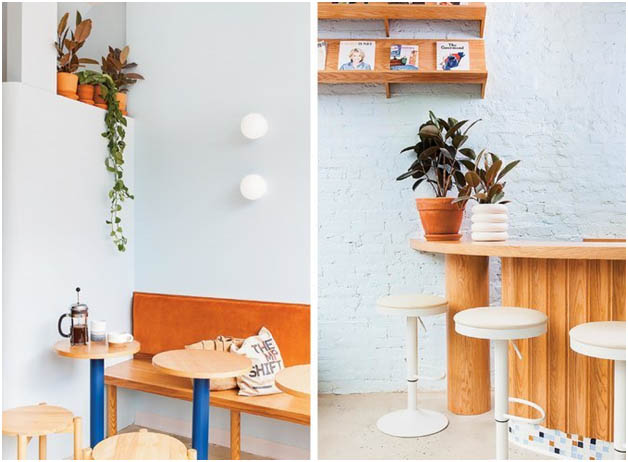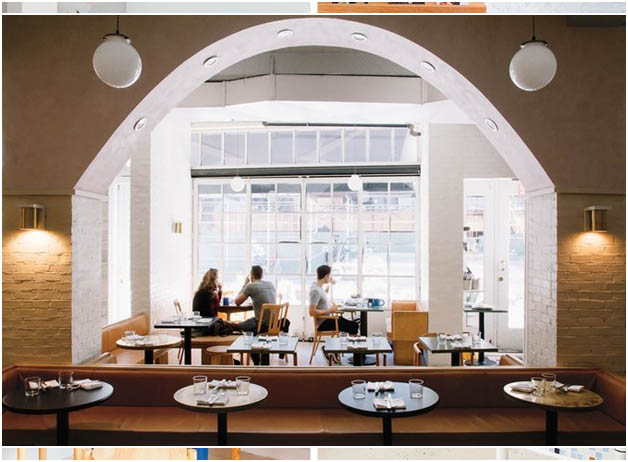ON A FALL afternoon at De Maria, a year-old restaurant in New York’s NoLIta neighborhood, the flat city light pours in from a wall of windows onto square tables covered in worn pistachio-green and navy leather. Diners can sit on squat wooden chairs, a tan-leather banquette or felt-topped stools at the bar, which is lit by orblike pendants and backed by a Bauhaus-via-Brazil geometric tile mural. They might order a chai latte, which arrives in a stoneware mug made by Brooklyn’s Workaday Handmade, or a cured-salmon and coconut grain bowl, off seasonal menus that are available from early in the morning until late at night.
Beyond the virtuous food, the space itself is somehow salubrious, as if solely by being here you are improving your life. Along with places like Kismet in Los Angeles, June’s All Day in Austin and Res Ipsa in Philadelphia, De Maria is part of a new class of American restaurants — or rather, “all-day cafes” — that combine highly specific, instantly recognizable décor with visually pleasing riffs on health-store classics like flaxseed banana bread and acai. These new cafes, all of which owe a debt to New York’s abstemious Dimes, which opened in Chinatown in 2013, present amiable aesthetic experiences that feel ready-made for Instagram: Many of these rooms share the same natural light, blond wood chairs and copper details that have come to evoke a kind of Scandinavian-inflected, aspirational millennial apartment, which the cafes themselves tend to resemble.
De Maria’s interior, in particular, is the work of the MP Shift, a Chinatown-based design and branding studio that, since its founding three years ago, has created variations on this look for several New York City restaurants and is now expanding throughout the country — as well as to Paris, London and Sydney. The studio was established by Amy Morris and Anna Polonsky (the M and P of the name, plus shift as in “late”), who met a decade ago through mutual friends, when Morris was a marketing consultant and Polonsky was a managing partner at a culinary events company. The young chefs and restaurateurs they encountered in those jobs were often interested in developing independent projects but lacked the proper guidance, so the two women decided to build an agency that consolidated graphics, interiors and brand-direction.
If it’s well established that we eat with our eyes, then the MP Shift is selling a related truth: In our digital age, a restaurant’s interior must be as satiating as its food. Officially, Morris and Polonsky have little to do with what’s on a client’s menu (aside from its logo, typefaces and layout), but they have tended to partner with chefs who prefer serving things like cerulean spirulina smoothies and magenta-hued radicchio salads that feel intended for future snapshots. The plating, too, reflects an understanding of what appeals to these restaurants’ intended psychographic: It’s heavy on swooshes of creamy sauces and bright, clashing layers of tropical fruits or local vegetables in flattened, de Kooning-esque compositions, often rendered atop wide, shallow clay plates and bowls. The MP Shift doesn’t tell the kitchen staff how to assemble their ingredients, but they don’t need to; chefs these days must think as much like designers as they do cooks — indeed, their success depends upon it.

At left, the velvet-clad seating area at Brooklyn’s Golda. At right, the cafe’s custom oak-and-tile bar, with a white planter by Chen Chen & Kai Williams.

Golda’s acai yogurt bowl with lavender honey, oats, grains, fresh and dried fruits, hazelnuts and bee pollen. CreditEast Studio
What the MP Shift does do is help ensure that this all-day fare remains visually appealing no matter the hour, while also providing a growing community of urban freelancers a sort of idealized living-room-as-office, allowing a public space to masquerade as a private one. “In the morning, everyone is on their laptop here; people are spending more time in restaurants as their third space,” Morris says of De Maria, referencing a concept by the urban sociologist Ray Oldenburg, who argued in 1989’s “The Great Good Place” that communities thrive in social spaces beyond homes and offices. These days, she says, “You’re asking for a restaurant to be more than just food.”
RESTAURANTS, OF COURSE, have always been about more than just the food, whether it was New York’s Four Seasons, designed in the International Style by Philip Johnson and William Pahlmann in 1958, or the organic austerity of the French Laundry, opened in Napa County in 1978, which for decades has defined a particular indoor-outdoor Northern Californian reverie. Meals worth traveling for are usually complemented by service and décor that’s meant to soothe, excite or even dazzle in person. But now that every diner has a camera in her handbag, restaurateurs have been forced to acknowledge that what they’re creating is not just a place where people consume meals but an aspirational space that, for many who experience it, exists only online. So even casual cafes — the sort that the MP Shift often designs — have to be stunning and distinctive enough to woo potential diners.
Morris and Polonsky’s projects often reflect the idea that these places become most enticing when filled with the same global, minimalist details (imported tiles, Alvar Aalto stools, oak tables) that appeal when encountered on social media, whether in pictures of other restaurants, or even of homes or hotels. “They asked me to open a Pinterest account,” says Gonzalo Goût, the co-owner of Verde, an erstwhile salad counter in New York’s Chelsea neighborhood, who hired the MP Shift in 2016. All of Verde’s ingredients came from the farmer’s market, so Goût used his virtual mood board to create a look that “conveyed that sense of the natural,” he says. Following this exercise, Morris and Polonsky built a dramatic counter of triangular slices of green and pink marble, which also adorned the facade as terrazzo. The final touch was the logo, with the restaurant’s name rendered in a fat, cheery pink-and-green sans serif.
At left, duck breast with charred eggplant jam and rutabaga at New York’s Ferris, for which the MP Shift designed the visual identity. At right, De Maria’s dining room features paintings by the Brooklyn-based duo Dylan Dylan on a wall of wooden slats. CreditFrom left: Noah Fecks; Rich Gilligan
As Morris and Polonsky’s portfolio grows, new clients increasingly reach out because they want to replicate a detail that they’ve seen only in photographs. In Houston, Kelly Barnhart will soon open Vibrant, an all-day cafe serving “adaptogenic potions” and grain salads out of a former laundromat. She was impressed with De Maria after seeing the space in a magazine, and brought the MP Shift on as consultants last spring. Working with Lake Flato, a local architecture firm, Barnhart plans to install long, leather-clad L-shaped banquettes, vintage Tobias Scarpa lamps and drawings by the New York artist Karin Haas, whose work abstracts patterns she finds in nature.
The room’s look will probably feel familiar: comforting, even. But having become known for an identifiable style over the past few years, Morris and Polonsky are now at pains to escape its tyranny. Back at De Maria, Polonsky points out a geometrically patterned wall inspired by kintsugi (the Japanese art of repairing broken pottery with thin threads of lacquer mixed with precious metals) that they created by filling cracks within the restaurant’s vintage subway tiles. Potential clients constantly request this motif, but Morris and Polonsky aren’t interested in replicating it. Likewise, they avoid Prouvé chairs and parti-colored Max Lamb marble. “It’s so easy for our clients to say, ‘We should do a pink place with midcentury chairs,’ ” Morris says. “But we don’t want them to fall into that trend. We don’t want them to say, ‘Let’s put avocado toast on the menu.’ ”
Instead, one of the MP Shift’s new European clients is adopting a primary-colored palette that seems inspired, in part, by another recent internet phenomenon: the resurgence of the designer Ettore Sottsass and his Memphis Group. At the forthcoming Parisian cafe Echo, the menus and logo will feature Crayola red, blue and yellow that suggest mid-80s Los Angeles. Morris and Polonsky predict Europe’s next trend-driven restaurant interiors might include angular Serge Mouille sconces and chrome seating, Formica counters and linoleum floors; in this context, these mundane American surfaces would likely feel modern. Though soon enough they, too, will be retired, making way for a new aesthetic to serve a new generation of diners who need to rest their phone on a lambent tabletop, order a hemp-milk cortado and, perhaps, post a photo or two.



















Your Message